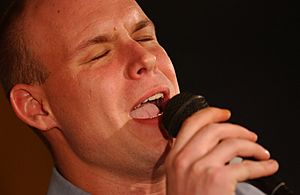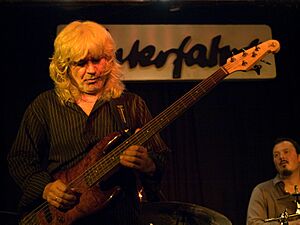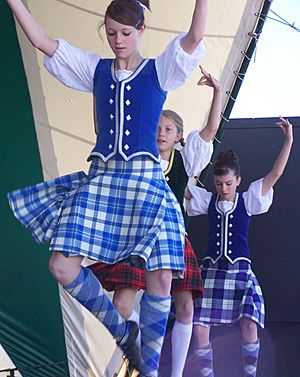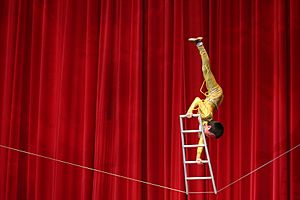Audition facts for kids
An audition is a short performance where actors, singers, dancers, or musicians show their skills. It's like a tryout for a job in the performing arts. Usually, performers show a piece they have practiced a lot. Sometimes, they get new material to perform right there. For example, an actor might do a monologue, a singer might perform a song, and a dancer might show a routine.
Auditions help professionals choose the best performers. It's similar to a job interview for other jobs. The people hiring want to see if you have the right skills. They also check if you can follow directions well. After showing their talent, performers might answer a few questions. These questions are often about their availability.
Auditions are needed for many reasons in the arts. Companies use them to pick performers for upcoming shows. An audition might be for one show or a whole season. It could also be for a permanent job with a group, like an orchestra. Auditions are also used for school programs or training. They can help you get into a ballet school or a university music program. You might also audition for scholarships or to find a talent agent.
Contents
Actors: How to Audition for Roles
For actors in theater, movies, and TV, auditions help choose who gets a part. These decisions are made by casting directors, producers, and directors. In film and TV, an audition is called a screen test. It is filmed to see how the actor looks on screen. Auditions are announced in newspapers or online. Many performers hire an agent to help them find auditions. Agents know many casting directors. However, agents usually take a part of the actor's earnings.
When choosing an audition piece, actors pick a monologue. It should be from a character close to their own age. They often wear simple clothes that allow them to move easily. Actors try not to go over the time limit. Sometimes, the judges might ask the actor to look at them directly. Actors warm up before an audition, just like athletes do. This might include vocal exercises and stretching. Dressing well is also important, even if it's just clean, simple clothes. Casting directors also look for actors who are easy to work with. They want someone who can take directions well.
Audition pieces are not always from the show itself. An actor trying out for Hamlet might not use a monologue from that play. Actors usually have different pieces ready. They pick one that fits the style of the show. For Hamlet, a dramatic Shakespearean monologue would be best. Some auditions involve cold reading. This means performing a script you have not seen before. Sometimes, actors read a scene with another person.
For most auditions, actors bring a "head shot." This is a professional 8x10 inch photo. They also bring a resume of their acting experience. Actors might bring extra copies for other casting team members. The casting team might call actors back for a second audition. This can happen days or even months later. At big auditions, time limits are very strict. A musical theater performer might have only a minute or two. A buzzer sounds when time is up, and the actor must stop.
Sometimes, new instructions are given right before the audition. For example, the time limit might be cut in half. Actors know it's important to follow these last-minute changes. Directors might also ask for changes in how lines are said. This shows if the actor is flexible and easy to work with. If a script is given early, actors try to memorize it. This shows they are prepared and lets them show more facial expressions.
Film auditions are a bit different from theater auditions. Actors get "sides," which are a few pages from the script. These are usually given 1-3 days before the audition. Today, video auditions are common. Casting directors can ask actors from other places to send a video. When recording a video audition, make sure the camera quality is good. Also, use good natural lighting. Always follow all instructions carefully.
Music Auditions
Popular Music Auditions
Instrumentalists: Playing for a Band
For jazz or rock bands, musicians might need to sight-read music. This means playing music they have never seen before. In jazz, they might play standard songs with the band. In rock or blues, they might play a well-known song. A drummer might play different styles, like a slow ballad or a fast swing. A bassist might play a Motown or funk style bassline. Some musicians might also need to sing backup.
Musicians trying out for a solo part play prepared solos. These solos show off their skills. They show how well they can play a melody or difficult parts. In some styles, like jazz, they might need to improvise a melody. In rock music, musicians are expected to have memorized their music. In classical music, they usually read from sheet music. For some rock or punk bands, it's important to move around a lot on stage.
Singers: Trying Out Your Voice
Singers auditioning for pop, rock, or country music show they can sing that style. A singer for a musical theater show would not sing opera. Sometimes, a musical theater audition needs a song from that musical's style. For example, for Destry Rides Again, a country song might be asked. For The Rocky Horror Show, a rock song might be needed.
For smaller roles in big musicals, many people audition at once. These are called "cattle calls." Many hopeful performers gather in one large room. The musical A Chorus Line shows this type of audition. American Idol also uses this method for its many singers. In musical theater, singers might also need to show they can dance while singing. Some rock bands might ask a backup singer to play an instrument too. This could be a simple guitar part or percussion.
Some popular music styles expect singers to know multiple languages. For example, Bossa Nova might need Portuguese songs. Tango might need Spanish songs.
Classical Music Auditions
In classical music, auditions help choose musicians for orchestras or choirs. They also help pick solo performers. Classical auditions are usually more formal. Performers might wear a tuxedo or a formal dress. Judges sit at a desk and write notes.
Instrumentalists: Playing for an Orchestra
Classical musicians often play pieces that are well-known for their instrument. For orchestras, they play parts from famous orchestral pieces. These parts can be solos or difficult group sections. An orchestra audition panel includes the conductor and main players. In the US, a union representative might be there too. Sometimes, a screen is used so judges can't see the performer. This helps keep things fair.
Orchestral auditions often list specific pieces to prepare. Performers also play a movement from a sonata or concerto. This might be with a piano player. Orchestral auditions often have several stages. Many people apply for professional orchestra jobs. The best candidates are chosen for the first audition. Then, the most promising ones come back for more rounds. This helps the conductor compare the best players. If a musician passes, they usually have a trial period. This lets the orchestra see if they fit in well.
Singers: Classical Voice Auditions
Classical singers also have standard songs for auditions. These depend on their voice type (like soprano or alto). A choir singer needs to be able to sight-read choral music. For opera auditions, singers must also act out the song's movements. This might include pretending to die or doing a simple dance. Both choir and opera singers must follow the conductor's hand signals. Since classical music usually doesn't use microphones, singers must project their voice loudly. Judges also check if singers can use the right pronunciation. This is important for languages like German, Italian, and French.
Musical Theatre Auditions
Musical theater needs good singing, acting, and dancing skills. A musical theater audition usually has two or three parts. These are a vocal audition, a dance audition, and sometimes a monologue. For singing, performers usually prepare two songs. These songs should be different in style or character. If there's a monologue, it's usually one minute long. A headshot and resume are almost always needed.
The main goal of the first audition is to get a "callback." Callbacks are second auditions. Here, the artistic team looks at specific characters. They ask the performer to sing songs or read lines for those parts. The first audition is just to show off your best songs.
Dance Auditions
There are many types of dance auditions. Dance companies hire dancers for ballet and modern dance shows. Broadway shows hire dancers for musicals. Casinos, resorts, and cruise ships hire dancers for revue shows. These might need jazz or hip-hop dancers. Sometimes, dancers also need to sing backup or act. Pop music concerts and videos also hire dancers. For live concerts, dancers might need to sing simple backup parts. Movies and TV shows hire dancers for short jobs.
Most auditions say what kind of dance skills are needed. This could be classical, jazz, or hip-hop. For modern dance, some companies ask dancers to improvise. Many dance auditions test how fast you can learn new choreography. Sometimes, a short prepared solo piece is also needed. This is usually about 90 seconds long. Applicants might be taught a routine in a group. Some auditions need dancers to have trained at a dance school. They might also ask for a reference letter from a dance teacher. At some auditions, dancers say why they want to join the group. Dancers should know major dance terms. Judges might ask them to show certain moves.
Dancers often bring one or two photos. This includes a "headshot" and a full-body photo in a dance pose. What to wear depends on the audition. For classical auditions, there's a strict dress code. Dancers wear leotards and pointe shoes. Long hair is tied back. Other auditions might allow loose clothing. Some contemporary dance auditions need dancers to be barefoot. For musical theater, tap shoes might be needed. If many people are auditioning, dancers might wear a number on their shirt. This helps judges remember good dancers. Dancers usually avoid jewelry and heavy makeup.
In musical theater and pop music, dancers often sing too. Most musical theater dancers are expected to sing backup. Sometimes, dancers might even need to play an instrument. This happens in shows where dancer-actors play instruments on stage. Dancers in musical theater might also need to act and speak lines.
Some big dance companies have "open calls" once a year. Anyone can come and show their skills. A choreographer teaches a routine to the group. Then, the dancers perform it while judges watch. It can be hard to stand out in a big group. Some dance coaches tell students to wear bright clothes. This helps them get noticed. For any audition, dancers should send their resume and headshot early.
Circuses and Amusement Parks
Performers for amusement parks audition in a rehearsal hall. Most theme park auditions are closed to the public. This means only those auditioning are allowed in. Singers for Disney auditions prepare two songs. They sing only the best 16 bars of each song. Disney provides a piano player, so singers bring sheet music. Disney does not allow pre-recorded music. The casting directors might also ask performers to learn new music or dance moves. Disney Parks & Resorts hires performers for theme parks, resorts, and cruise ships.
At Cirque du Soleil, an audition can last an hour or even two days. This depends on the performer's skill. Performers might do a solo act in front of others. They might also do group exercises. Cirque du Soleil auditions are always filmed.
Modelling Auditions
Modelling agencies and fashion designers also hold auditions. They look for new models. Most female fashion models are teens or early twenties. They need to be tall and slim. There are also "plus size models" and "real life models." These models show clothes for different body types. Young male models are usually 18-25, tall, and fit. While male models can work longer, agencies prefer to find new ones in this age range. Most models work with an agent. The agent helps them find auditions and jobs. At an audition, models show different poses. A photographer might take pictures.
For high fashion, models might walk on a raised runway. This is called a "catwalk." At most modelling auditions, models wear simple clothes. This helps agents imagine them in different outfits. Clothes are usually body-hugging so judges can see the model's shape. Some agencies have "open calls" where they see many models quickly. Some agencies also hold model searches. These are like contests where applicants audition to win a model portfolio.
See also
 In Spanish: Prueba de artes escénicas para niños
In Spanish: Prueba de artes escénicas para niños
- Casting (performing arts)
- Screen test
- Audition website











